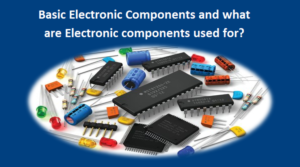
Building electronic circuits require a number of basic electronic components that are necessary to complete the circuit designs and for their functioning. But what are these basic electronic components and for what purposes they are used?
Here is a brief overview of the basic electronic components, their types and some of the essential electronics components with their functions.
What are Basic Electronic Components?
Basic Electronic Components are the building blocks of an electronic circuit or electronic device. These are the basic discrete devices in any electronic system or basic element used to design electrical and electronic circuits. Without these components, a circuit design is incomplete as these components control the flow of electrons in an electronic circuit. These components are very small and consist of two or more terminals, soldered to circuit boards to connect the circuit. Some of them may be packaged types like integrated circuits such as AMI semiconductor ICs, in which different semiconductor devices are integrated. A useful electronic circuit is formed when a group of these basic electronic components are connected together in an electronic board such as PCB.
Essential Electronics Components and their functions:
The electronic components are generally classified into two categories:
Passive components: These electronic components consume energy in the form of voltage from the source and store the electrical energy temporarily in the form of magnetic field or static electric field. These components do not produce or supply energy. The types of passive components include Transformer, Resistors, Capacitors, and Inductors.
- Transformer: A passive electrical device used in the power transmission of electric energy. It consists of two coils of wire linked by an iron core and transfers electrical energy from one electrical circuit to another circuit, or multiple circuits. The transformer is widely used in the transmission and distribution of alternating current power. Its main function is to increase (step-up) or decrease (step-down) AC voltages
- Resistors: A two-terminal passive electronic component that restricts the flow of current in the circuit. The resistor absorbs the electrical energy and degenerates it in the form of heat when a current flows through it. The resistance value of a resistor determines how much electric current does a resistor reduce or limits.
- Capacitors: Made from two conductive plates with an insulator between them, a capacitor stores the electrical energy. When an electric charge is forced onto the terminals of a capacitor, it stores electrical energy in the form of a static electric field.
- Inductors: Inductor temporarily stores electrical energy in the form of magnetic energy and opposes sudden changes in current. It consists of a coil of copper wires in which a magnetic field is produced and stored when an electric current is passed through it.
Active components: These electronic components supply or produces energy in the form of voltage or electric current and increases the power of the electronic signals. In order to perform a specific operation, these components depend on the external source of energy or voltage. Some of them include Diodes, Transistors, integrated circuits (IC), Battery, Microcontroller, Switches, Relays etc.
- Diodes: Made from a semiconductor material, a diode is a device that allows current to flow in one direction only. It consists of two terminals or electrodes known as cathode and anode used in converting circuits like Alternating current (AC) to Direct Current (DC) circuits.
- Transistors: A three-terminal semiconductor device capable of amplification, controlling, and generating electrical signals. It is a miniature device that control or regulate the flow of voltage or current and used as a switching device and as an amplifier.
- Integrated circuits (IC): A semiconductor device fabricated with millions of resistors, transistors, diodes or capacitors and other electronic components in a tiny piece of silicon chip. Also called a microchip, these ICs are the building blocks of many electronic devices like computers, cell phones, watches etc.
- Battery: A kind of electrical energy storage device that is used to convert chemical energy into electrical energy to supply the power to various electronic devices. It consist of one or more cells and are classified into two types; primary or disposable batteries and secondary or rechargeable batteries.
- Microcontroller: Also known as MCU (microcontroller unit), a Microcontroller is a small computers on a single compact integrated circuit. It is designed to execute a specific task within an embedded system and has various applications in home appliances, vehicles, remote controls, mobile radio transceivers and other embedded systems etc.
- Switches: An electrical device that is used to connect or disconnect the circuit and works with the ON and OFF mechanisms. A switch connecting together all the devices and supply the current from one conductor to another conductor.
- Relays: Electric switches used to control the circuits by using a low power signal and change low currents within a control circuit. They are used to perform logical operations in telephone exchanges and also for controlling high electric currents.


















